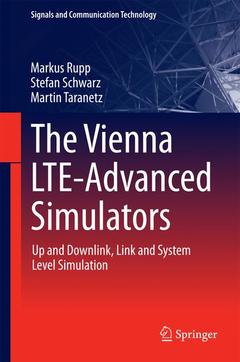The Vienna LTE-Advanced Simulators, Softcover reprint of the original 1st ed. 2016 Up and Downlink, Link and System Level Simulation Signals and Communication Technology Series
Auteurs : Rupp Markus, Schwarz Stefan, Taranetz Martin

This book introduces the Vienna Simulator Suite for 3rd-Generation Partnership Project (3GPP)-compatible Long Term Evolution-Advanced (LTE-A) simulators and presents applications to demonstrate their uses for describing, designing, and optimizing wireless cellular LTE-A networks.
Part One addresses LTE and LTE-A link level techniques. As there has been high demand for the downlink (DL) simulator, it constitutes the central focus of the majority of the chapters. This part of the book reports on relevant highlights, including single-user (SU), multi-user (MU) and single-input-single-output (SISO) as well as multiple-input-multiple-output (MIMO) transmissions. Furthermore, it summarizes the optimal pilot pattern for high-speed communications as well as different synchronization issues. One chapter is devoted to experiments that show how the link level simulator can provide input to a testbed. This section also uses measurements to present and validate fundamental results on orthogonal frequency division multiplexing (OFDM) transmissions that are not limited to LTE-A. One chapter exclusively deals with the newest tool, the uplink (UL) link level simulator, and presents cutting-edge results.
In turn, Part Two focuses on system-level simulations. From early on, system-level simulations have been in high demand, as people are naturally seeking answers when scenarios with numerous base stations and hundreds of users are investigated. This part not only explains how mathematical abstraction can be employed to speed up simulations by several hundred times without sacrificing precision, but also illustrates new theories on how to abstract large urban heterogeneous networks with indoor small cells. It also reports on advanced applications such as train and car transmissions to demonstrate the tools? capabilities.
Introduction.- Link Level Simulation Basics.- Downlink Synchronization.- Symbol Detection in High Speed Channels.- Optimal Pilot Pattern for Downlink Transmissions.- Single User MIMO LTE Transmission with Quantized Feedback.- Multi User and Multi Cell Simulations.- Advanced Multi User MIMO Concepts.- LTE-Advanced Uplink Transmissions.- LTE-Advanced Uplink Transmissions.- Basic System Level Simulations and Advanced Features.- Modeling Regular Aggregate Interference by Symmetric Structures.- Modeling Asymmetric Aggregate Interference by Symmetric Structures.- Analysis of Urban Two-Tier Heterogeneous Cellular Networks.- Simulation of Two-Tier Heterogeneous Cellular Networks.- Advanced System Level Applications.
Markus Rupp was born in 1963 in Völklingen, Germany. He received his Dipl.-Ing. Degree in 1988 at the University of Saarbrücken, Germany, and his Dr.-Ing. degree in 1993 at the Technische Universität Darmstadt, Germany, where he worked with Eberhardt Hänsler on designing new algorithms for acoustic and electrical echo compensation. From November 1993 until July 1995, he held a postdoctoral position at the University of Santa Barbara, California, with Sanjit Mitra where he worked with Ali H. Sayed on a robustness description of adaptive filters with impact on neural networks and active noise control. From October 1995 until August 2001, he was a member of Technical Staff at the Wireless Technology Research Department of Bell-Labs in Crawford Hill, NJ, where he worked on various topics related to adaptive equalization and rapid implementation for IS-136, 802.11 and UMTS. In October 2001 he was appointed a Full Professor of Digital Signal Processing in Mobile Communications at the Technische Universität (TU) Wien, where he served as the Dean from 2005 to 2007 and from 2016 to 2017. He was associate editor of IEEE Transactions on Signal Processing from 2002 to 2005 and is currently associate editor of JASP EURASIP Journal on Advances in Signal Processing, and JES EURASIP Journal on Embedded Systems. He is a Fellow of the IEEE and was elected AdCom Member of EURASIP from 2004 to 2012, serving as President of EURASIP from 2009 to 2010. He has authored and co-authored more than 500 scientific papers, including 15 patents on adaptive filtering and wireless communications.
Stefan Schwarz was born in Neunkirchen, Austria, in 1984. He received his B.Sc. degree in electrical engineering and his Dipl.-Ing. degree (M.Sc. equivalent) in telecommunications engineering with the highest distinctions in 2007 and 2009, respectively, both at TU Wien. He also received his Dr. techn. degree (Ph.D. equivalent) in telecommunications engineering with the highes
Date de parution : 04-2016
Ouvrage de 357 p.
15.5x23.5 cm
Date de parution : 04-2018
Ouvrage de 357 p.
15.5x23.5 cm
Thèmes de The Vienna LTE-Advanced Simulators :
Mots-clés :
Link and System Level Simulation; OFDM and SC-FDMA; Downlink Synchronization; Long Term Evolution-Advanced LTE-A; Single-User (SU) and Multi-User (MU) MIMO transmission; Feedback-quantization; LTE-A Uplink Transmissions; Heterogeneous Cellular Networks; Urban Two-Tier; Small Cells; 3-dimensional Channel Modeling; information and communication; circuits



